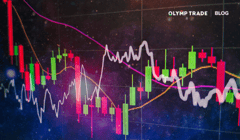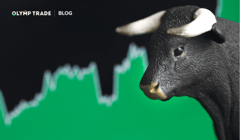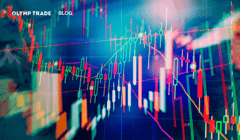
Last week, the US Fed's Open Market Committee decided to raise its key rate by 25 basis points. The head of the FOMC, J. Powell, said that there would be no recession. The market did not believe that. So, what is happening with the American and European economies? More on that in our news release today.
Interact with the dashed blue word and green spot on images to get additional details and explanations.
More details on the visuals will be here.
A term definition or explanation will be here.
Contents
Weekly Trends
Nvidia ↑ +12.06%
Trading long with a $100 and X20 multiplier could have been worth $241.2.
NZD/JPY ↑ +2.57%
Trading up with a $100 and X500 multiplier could earn $1285.
USD/CAD ↓ -1.04%
Short trading with a $100 and X500 multiplier could earn you $520.
Currency Markets
The Situation With Inflation is Worsening
Last week, the dollar corrected slightly. Key currencies managed to rise against the USD. A particularly noticeable upward movement was formed in the AUD/USD pair. It unfolded on March 15 and formed the classic “morning star” candlestick pattern.

The Australian dollar was supported by the data on unemployment, published on Thursday morning. Unemployment in Australia amounted to 4%, while the forecast value was +4.1%. Meanwhile, the Meeting Minutes of the Reserve Bank of Australia came out quite calming for the markets. The RBA confirmed that the country's inflation has increased, but less than in other countries. Indeed, the current inflation rate in Australia is about 3.5%, while in Europe the CPI in annual terms is approaching 6%.
The growth of the Australian dollar may possibly be an attempt by the market to find a kind of "safe haven" against the backdrop of geopolitical uncertainty. If this is true, then the current macroeconomic events can completely reformat the global trend. In the traditional system, we see currencies strengthening when inflation rises - this reflects the markets' expectations for further tightening of monetary policy. Monetary policy is a set of tools that a nation's central bank has available to promote sustainable economic growth by controlling the overall supply of money available to the nation's banks, consumers, and businesses. However, although traders may not believe that, a rate hike can put pressure on inflation. That means they can now choose for trading the currencies of those countries where inflation is growing less quickly. As a result, the AUD should be looked at as a possible upside candidate, especially if this global macro picture is confirmed by technical factors.

Inflation Growth in the EU Exceeded Expectations
Published on Thursday, data on inflation in the European Union exceeded the expectations of economists. In annual terms, inflation rose by 5.9% in February, while only 5.8% was expected. The key factor putting pressure on the European economy is undoubtedly energy prices. We can add to this food prices, given the disruption and cost of supply chains. This week, the EUR corrected slightly against the US dollar. EUR/USD tested the level of 1.10500.
On the daily chart, a triangle chart pattern is formed. That is a trend continuation pattern. However, bulls may try to counterattack now. The short-term target for EUR/USD is the range of 1.11000 - 1.112000 again. However, even with these moves, the global picture does not change. We continue to believe that EUR/USD will keep declining.

Price target 1.11-1.11200
Local trend line
Stock Markets
American Stock Market
There is multidirectional movement in different sectors. The rebound was provided by the financial sector. American stock indices rose last week. Dow Jones added about 3.8%, Nasdaq100 rose by 7.2%, and the S&P500 by 4.7%. Dynamics in various sectors are multidirectional. However, financial sector stocks were able to provide significant support to the market. Shares of JP Morgan Chase, Bank of America, and Citigroup rebounded rather well.

As we said, the banking sector is to some extent a beneficiary of the key rate increase. Nevertheless, the current movement can be considered only within the framework of a correction. In the long term, we expect the US stock market to continue to decline.
The Fed's rate hike, coupled with Powell's rhetoric, was met by a rise in the stock market, when in fact it should have been the other way around. Moreover, economists have noticed that the US yield curve treasuries is becoming more and more inverted, which means the economy is sinking deeper into recession. Real interest rates are negative.

Amazon Tested $3,000 Again
As we expected, the price of Amazon shares tested the level of $3,000. On the daily chart, the trend line was broken upwards, followed by the price reaching its upper range. Will the bulls manage to gain a foothold higher? This largely depends on whether the price can now break through the $3,100 mark. While the likelihood of that is not that high, it is still possible.

Crucial trend line/Resistance level
Commodity Markets
Oil Has Corrected, but for How Long?
At present, the risks for the energy market remain the same. Geopolitical tensions are causing the United States to frantically search for replacements for Russian energy carriers that have become “toxic” amid the imposed sanctions. Venezuela, Iran, and Saudi Arabia are the three countries that can really create an offer on the market. But at the moment, all three of them have refused the deal. Sanctions have been imposed on Venezuela and Iran. The Venezuelan Foreign Ministry has already stated that Caracas is a true ally of Russia, Iran has abandoned the nuclear deal without taking into account the interests of Moscow, and Saudi Arabia is also more inclined to cooperate with Russia and China.
Cartel countries of OPEC are also in no hurry to increase production.
This week, the rise in oil prices has somewhat slowed down. The price corrected to the level of $105 per barrel, and at some moments even dropped below $100. However, this correction does not affect the overall picture yet. The probability of continuing price growth is quite high.

Gap down from 15.03
Support level/trend line
From a technical point of view, the “morning star” Japanese candlestick pattern has formed on the “daily” chart. The price closed gap on 03/16 and resumed growth with an eye to closing another gap on 03/15.
The Situation in the Gold Market is Similar to the Oil Market
Like the oil market, the gold market has somewhat corrected. The price even managed to return to $1,900 per troy ounce, but then the fears still took their toll - the growth continued. As for gold, now it is perhaps one of the most obvious and win-win choices for traders. In moments of such strong turbulence, the classical understanding of gold as a defensive asset will cause investors to return to the markets, which means only an increase in demand.
Goldman Sachs draws the attention of its clients to the fact that in the 1970s, it was gold and commodities that became the main beneficiaries. This was also stated by Jeffries, Saxo Bank, and Black Rock.

Thus, the largest investment houses are convinced that we are on the verge of a strong and long supercycle in gold. Therefore, we are likely heading into a bullish trend. That’s why we consider the continued growth of the gold price as the most likely scenario ahead.
Cryptocurrency Markets
Will Bitcoin be the Beneficiary?
Another possible beneficiary of the total uncertainty in the markets could be cryptocurrencies. The fact that Bitcoin can act as a safe haven asset from rising inflation has been talked about for a long time. Amid tensions, CME notes a sharp surge in volumes for Bitcoin futures trading.

Bitcoin consolidated around the 41000 mark this week. It is possible that the price is feeling the bottom. However, we recommend you open long positions on Bitcoin only after a full resumption of growth. We would put a mark at 46,000. If the bulls manage to push the price higher, then we can join the general growing trend.

Resistance level of 45,000
Risk warning: The content of the article does not constitute investment advice and you are solely responsible for your trading activity and/or trading results.
The unemployment rate is the percentage of the labor force without a job. As it is a lagging indicator, it generally rises or falls in the wake of changing economic conditions, rather than anticipating them.
An ascending triangle is a chart pattern used in technical analysis. It is created by price moves that allow for a horizontal line to be drawn along the swing highs and a rising trendline to be drawn along the swing lows. The two lines form a triangle. Traders often watch for breakouts from triangle patterns. The breakout can occur to the upside or downside.
The key rate is the specific interest rate that determines bank lending rates and the cost of credit for borrowers.
Treasury bonds, or T-bonds, are government debt securities issued by the US.
The real interest rate of an investment is calculated as the difference between the nominal interest rate and the inflation rate.
A gap occurs when the opening price is above or below the previous closing price, with no trading activity in between.
A bull market is the condition of a financial market in which prices are rising or are expected to rise.











